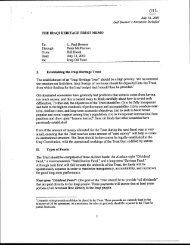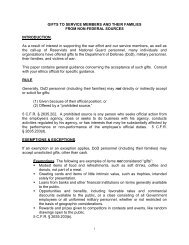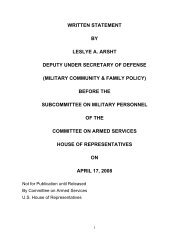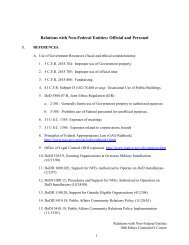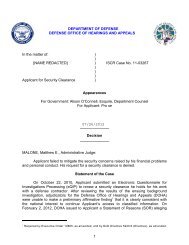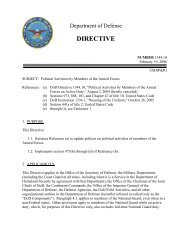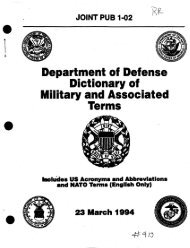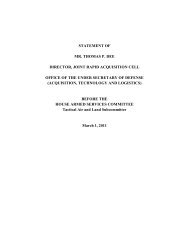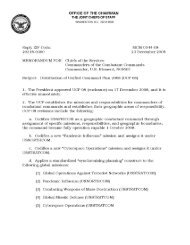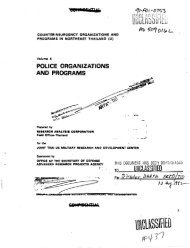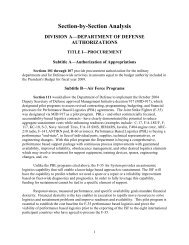dod tactical herbicide sites - United States Department of Defense
dod tactical herbicide sites - United States Department of Defense
dod tactical herbicide sites - United States Department of Defense
You also want an ePaper? Increase the reach of your titles
YUMPU automatically turns print PDFs into web optimized ePapers that Google loves.
DOD TACTICAL HERBICIDE SITESSite 22Location: Adjacent to the Demilitarized Zone, KoreaDate → 20 March 1968 – 1 July 1968Activity Description: In early 1967, as part <strong>of</strong> a general review <strong>of</strong> theDemilitarized Zone (DMZ) defenses, the <strong>United</strong> Nations Command (UNC) and the<strong>United</strong> <strong>States</strong> Forces Korea (USFK) found that dense vegetation within the DMZ andcontiguous areas provided cover for North Korean infiltration or raiding parties. Thevegetation in these areas had grown unencumbered since the Armistice and was animportant part <strong>of</strong> the DMZ defensive problem. In March 1967, representatives <strong>of</strong> thePlant Sciences Laboratory, US Army Biological Laboratories, Fort Detrick, Marylandvisited Korea and inspected typical vegetation growth in selected areas contiguous to theDMZ. Based upon this evaluation, the Plant Sciences Laboratory recommended the use<strong>of</strong> <strong>tactical</strong> <strong>herbicide</strong>s, specifically Herbicides Orange and Blue, and a commerciallyavailable soil applied <strong>herbicide</strong> (Monuron UROX 22) to control general and specificvegetation growth adjacent to the DMZ.The decision to use <strong>tactical</strong> <strong>herbicide</strong>s required obtaining approval <strong>of</strong> the <strong>United</strong> <strong>States</strong><strong>Department</strong> <strong>of</strong> State. Numerous messages were dispatched during the period Maythrough September 1967. In early September, the US Secretary <strong>of</strong> State authorizeddiscussion <strong>of</strong> the program with the Republic <strong>of</strong> Korea (ROK) Government. Thesediscussions provided the acceptance <strong>of</strong> the program by the ROK Prime Minister and on20 September 1967 both governments (ROK and US) granted permission for the use <strong>of</strong>the <strong>tactical</strong> <strong>herbicide</strong>s to be sprayed in the area between the DMZ South tape and theCivilian Control Line.Following a series <strong>of</strong> planning conferences a comprehensive vegetation control programwas developed. On 4 March 1968, the Commander, US Forces in Korea(COMUKOREA) was authorized to deploy <strong>tactical</strong> <strong>herbicide</strong>s as part <strong>of</strong> the vegetationcontrol program in Korea. To preclude the possibility <strong>of</strong> unfavorable propaganda and toensure that defoliants would be properly employed with a margin <strong>of</strong> safety, the followingconstraints were placed upon the vegetation control program: (a) Defoliants were not beemployed North <strong>of</strong> the Southern boundary <strong>of</strong> the DMZ; (b) During application, care wasto be taken to ensure that there was neither run-<strong>of</strong>f nor spray drift into areas North <strong>of</strong> theSouthern boundary <strong>of</strong> the DMZ; (c) Defoliants would not be applied during precipitationor when rain was expected within 12 hours after application; (d) Extreme caution was tobe exercised to avoid damage to food crops; (e) Defoliants would note be dispensed fromaircraft <strong>of</strong> any kind; and (f) a Korean Military Assistance Group (KMAG) Representative51



